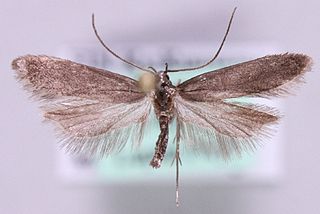
Pouteria sapota, the mamey sapote, is a species of tree native to Mexico and Central America. The tree is also cultivated in the Caribbean. Its fruit is eaten in many Latin American countries. The fruit is made into foods such as milkshakes and ice cream.

Caryocolum petryi is a moth of the family Gelechiidae. It is found in France, Germany, Austria, Switzerland, Italy, Slovenia, former Yugoslavia, Hungary, Latvia, Lithuania, Sweden and Finland. It is also found in Mongolia and Siberia (Tuva).
Caryocolum repentis is a moth of the family Gelechiidae. It is found in Spain, France, Germany, Austria, Switzerland, Italy, Slovenia and Russia.
Monochroa nomadella is a moth of the family Gelechiidae. It is found from southern and central Europe to the southern Ural. It is also found in Mongolia. Records of M. nomadella from France and north-western Italy refer to Monochroa bronzella. The species prefers calcareous habitats.

Acanthophila latipennella is a moth in the family Gelechiidae. It is found in south-eastern Siberia and Europe, where it has been recorded from Norway south to Italy and east to Russia.

Helcystogramma lutatella, the clay crest, is a moth in the family Gelechiidae. It was described by Gottlieb August Wilhelm Herrich-Schäffer in 1854. It is found in Uralsk, Transbaikalia, China and almost all of Europe.
Brachmia brunnea is a moth in the family Gelechiidae. It was described by John David Bradley in 1961. It is found on Guadalcanal.
Brachmia dolosa is a moth in the family Gelechiidae. It was described by Edward Meyrick in 1911. It is found in Sri Lanka.
Brachmia insulsa is a moth in the family Gelechiidae. It was described by Edward Meyrick in 1914. It is found in the Bengal region of what was then British India and the United Arab Emirates.
Brachmia officiosa is a moth in the family Gelechiidae. It was described by Edward Meyrick in 1918. It is found in southern India.
Dichomeris tostella is a moth in the family Gelechiidae. It was described by Stringer in 1930. It is found in Japan, Korea, and the Russian Far East.
Dichomeris barnesiella is a moth in the family Gelechiidae. It was described by August Busck in 1907. It is found in Mexico and Arizona.

Dichomeris loxospila is a moth in the family Gelechiidae. It was described by Edward Meyrick in 1932. It is found in India, China and Taiwan.
Dichomeris microsphena is a moth in the family Gelechiidae. It was described by Edward Meyrick in 1921. It is found in China, Taiwan, north-eastern India and Java, Indonesia.
Dichomeris hortulana is a moth in the family Gelechiidae. It was described by Edward Meyrick in 1918. It is found in India, South Africa, the Seychelles, where it has been recorded from Silhouette and Mahé as well as Mauritius and Mayotte.
Helcystogramma flavilineolella is a moth in the family Gelechiidae. It was described by Ponomarenko in 1998. It is found in south-eastern Siberia and China.
Myconita lipara is a moth in the family Gelechiidae. It was described by John David Bradley in 1953. It is found in Fiji.
Eustalodes anthivora is a moth in the family Gelechiidae. It was described by Clarke in 1954. It is found in the Philippines.

Eulamprotes atrella, the two-spotted neb, is a moth of the family Gelechiidae. It was described by Michael Denis and Ignaz Schiffermüller in 1775. It is found from most of Europe, east to Japan. The habitat consists of mixed deciduous woodlands.





